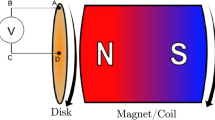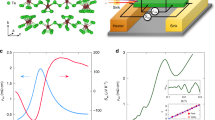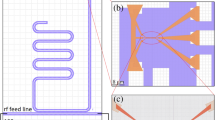Abstract
IT is well known that if, in a piece of semi-conductor such as germanium or silicon, a magnetic field is set up along the z-axis, as defined by a Cartesian coordinate system, with current flow at right angles along the y-axis, then an electromotive force appears, due to the Hall effect1 along the x-axis. This electromotive force at any instant is given by:  where B is instantaneous flux density in gauss; I
c is instantaneous current in amperes ; R is Hall coefficient in volt. cm. per ampere gauss (for ‘n’ type germanium R has a value of about 8 × 10−5) ; and t is thickness in cm. along the z-axis of the sample of material exhibiting the Hall effect. The particular virtue of a semi-conductor like germanium or silicon for this purpose is that it possesses a comparatively large Hall coefficient and allows a substantial penetration of the field into the material even at ultra-high frequencies.
where B is instantaneous flux density in gauss; I
c is instantaneous current in amperes ; R is Hall coefficient in volt. cm. per ampere gauss (for ‘n’ type germanium R has a value of about 8 × 10−5) ; and t is thickness in cm. along the z-axis of the sample of material exhibiting the Hall effect. The particular virtue of a semi-conductor like germanium or silicon for this purpose is that it possesses a comparatively large Hall coefficient and allows a substantial penetration of the field into the material even at ultra-high frequencies.
This is a preview of subscription content, access via your institution
Access options
Subscribe to this journal
Receive 51 print issues and online access
$199.00 per year
only $3.90 per issue
Buy this article
- Purchase on Springer Link
- Instant access to full article PDF
Prices may be subject to local taxes which are calculated during checkout
Similar content being viewed by others
References
Hall, E. H., Phil. Mag., 12, 157 (1880).
Author information
Authors and Affiliations
Rights and permissions
About this article
Cite this article
BARLOW, H. Application of the Hall Effect in a Semi-conductor to the Measurement of Power in an Electromagnetic Field. Nature 173, 41–42 (1954). https://doi.org/10.1038/173041a0
Issue Date:
DOI: https://doi.org/10.1038/173041a0
This article is cited by
-
Quantum theory of radiation-pressure induced electrical currents: I. Free electrons
Zeitschrift für Physik B Condensed Matter (1983)
-
Acousto-optical domain generation in CdS under intense laser irradiation and accompanying phenomena
Opto-electronics (1969)
-
The voltage sensitivity of Hall transducers at frequencies of 5500 and 10,000 Mc
Radiophysics and Quantum Electronics (1968)
-
Feasibility of using hall plates to monitor high-power microwave pulses
Radiophysics and Quantum Electronics (1968)
Comments
By submitting a comment you agree to abide by our Terms and Community Guidelines. If you find something abusive or that does not comply with our terms or guidelines please flag it as inappropriate.



